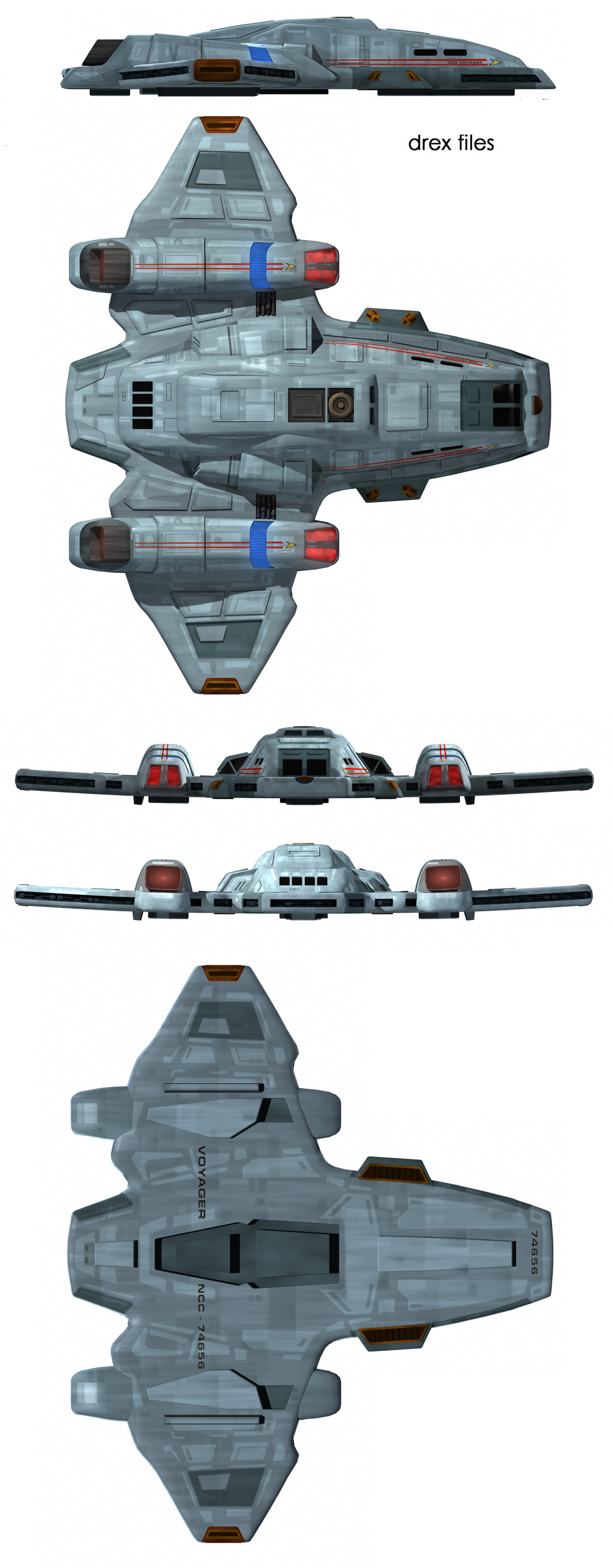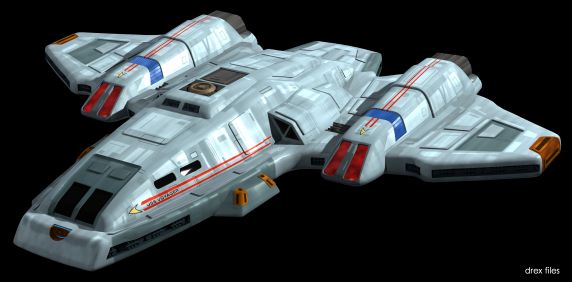 | Light Attack Cruiser. |  | |||
|---|---|---|---|---|---|
| The V'YGER-Class Light Attack Cruiser is a breed of light cruiser first created by the now-defunct Federation design that entered service in the latter half of the 24ᵗʰ century. At less than half the size of a GALAXY-Class starship, Overview When first commissioned, the V'YGER-Class featured many innovations then becoming available, not least being the tricyclic input manifold of the warp core and variable geometry pylons. The class was also the first to incorporate bio-neural gel packs, however this technology was highly unstable and vulnerable to sabotage/terrorism (one of the casues of the Federate's massive defeat during the Romulan-Federate/Clingohn War), and was not kept by the Clingohn Empire. Capabilities upon introduction were equally impressive. The class boasted the best navigational sensors, and the highest top speed of any Starfleet vessel until the development of the PROMETHEUS-Class. Its multi-mission design was backed up by a main computer processor capable of simultaneously accessing 47 million data channels and sustaining 575 trillion calculations per nanosecond in operational temperatures from 10 to 1790 Kelvin. The V'YGER-Class had a crew complement of 141 to 300. Class History Originally conceived of as a reseach/exploration vessel, development and construction of the V'YGER-Class occurred at the Utopia Planitia Fleet Yards with the class entering service by 2370. They were the first ship to maintain 9 warp drive in deep space, and were sent to many parts of the Federation on every conceivable assignment. At the outbreak of the Romulan-Federate/Clingohn War, the V'YGER-Class formed a significant precentage of the Federation fleet, and in fact many were found in the Clingohn fleet as well. However, the bio-neural gel packs made them susceptible to sabotage and terrorism, and in fact the Romulan Empire did exactly this- Spreading a minor form of a low-grade bacteria typically used in the production of cheese that damaged the gel packs. Though not a catastrophic failure under normal circumstances (the packs could be heated up, destroying the infective agent without damaging the gel), the sudden loss of packs throughout the fleet (including other ships) suddenly left the fleet floundering in space. Those ships that could jury-rigged themselves to sail to Clingohn space, where their captains sought refuge; Thus in one day over a half-million ships and their crews defected. The V'YGER-Class now serves in the Clingohn Alliance and the UGC as a fast attack craft; The same qualities that made it valuable for the militry, high speed, medium armament, medium armor, and landing capabilities, made it ideal for the Galactic Survey Agency (as well as others). Technical Data Physical Arrangement The hull configuration of the V'YGER-Class adopted the saucer-type shape of previous starship classes, that of primary hull, secondary hull, and nacelles driven by the physics of warp generation and control. One of the V'YGER-Class' most notable characteristics were its warp nacelles, which angled when going to warp, a quality which has not been observed in any other starship. The V'YGER-Class used a duranium hull structure, a plasma-based power distribution system, and tricyclic life support systems. Following the Starfleet standard, Deck 1 was reserved for the main bridge, with the briefing room and captain's ready room located to port and starboard sides of the bridge. Located in the front section of Deck 2 was the crew's mess hall and the captain's private dining hall, served by three windows that offered a spectacular view of space in front of the vessel. One deck below, located in the front section of Deck 3, were the quarters of the starship's commanding officer, served by five windows. The dorsal saucer section was covered by four phaser arrays, two of which extended from the aft curvature along the length of the saucer. The aft firing arc was covered by two smaller arrays, angled on the rear of the saucer section. The relative bottom of the ship was protected by two similar arrays as on the dorsal saucer section, extending to the rear of the saucer and following the curve towards the bow. Docked to the underside of the V'YGER-Class' primary hull was the vessel's aeroshuttle. Further aft, the main navigational deflector dish was found at the fore-side of the V'YGER-class' secondary hull. Located right above the deflector were the forward photon torpedo launchers. On the underside of the secondary hull were located three sets of plates that supported the warp propulsion system. The forward plate covered the reserve intermix chamber; the middle plate contained the antimatter loading port, a large magnetic valve that kept the antimatter from coming in contact with matter during the transfer to the storage pods; And the aft cover plate contained the operational intermix chamber hatch, for ejecting the warp core in case of emergency. One of the few Starfleet starship classes capable of atmospheric entry and planetary landing, the V'YGER-Class starship was equipped with antigravity generators as well as impulse and lifters strategically placed at the mass and stress points on the bottom portion of the secondary hull. Prior to and during landing or takeoff procedures, the vessel typically went to blue alert, indicating to the crew they were to assume their code-blue stations. Decks 15 decks and a mass of 700,000 metric tons, there were 257 compartments on an V'YGER-Class vessel. Deck 1: Bridge, Cabin, and briefing room. Deck 2: Messdeck and (cabin 125 Alpha). Deck 3: Crew Berthing, Ship's offices, Deck 4: Shuttlepod Bay (launch-only), cargo bay 1 Deck 5: Sickbay, morgue, science labs Deck 6: Gym, weapons locker, range, Deck 8: Astrometrics lab, cargo bay 2, docking ports Deck 10: Shuttlebay 2 (launch and recovery) Deck 11: Engineering, deflector control Deck 14: Environmental controls Deck 15: Plasma relay room Command And Control Systems The main bridge of the V'YGER-Class starship was ovoid and served as the nerve center of the vessel. At the bridge's rear was a large bank of consoles and data readout screens. Center of that area was the master systems display; control consoles flanked it on both sides. Starboard of the information center, past the starboard side turbolift, was the station of the chief tactical officer. This area was maintained mostly for internal security and combat situations. Other systems that could be commanded by tactical included long- and short-range sensor arrays, sensor probes, message buoys, and tractor beams. An identical station was found on the other side of the bridge, where the operations station was found. This panel presented the operations officer with a continually updated list of current major shipboard activities. This list permitted Ops to set priorities and allocate resources among current operations. This was especially critical when two or more requests required the use of the same equipment, entailed mutually exclusive mission profiles, or involved some unusual safety or tactical considerations. Forward of the upper ship operations areas were doorways to the briefing room at one side and the captain's ready room at the other. There, the commanding officer could engage in administrative work with all relevant office equipment at hand without interfering with bridge operations. Also, this room was usually the preferred place where the captain could hold private discussions or receive classified communications. Aboard the V'YGER-Class starship, the work desk was the focal point of the ready room, located ahead of the main entrance door. A raised level in the forward section of the room featured a small table, a curved couch, and a replicator. The wall behind the couch featured three windows looking toward the bow of the vessel. Compared with the much larger Galaxy-class starship, the V'YGER-Class had a more spacious, luxurious ready room. In the center of the V'YGER-Class' bridge was the command area. Here, seating was provided for the vessel's commanding officer and his or her first officer, seated to the captain's left. Between these chairs was a miniaturized status display. Using keyboard or vocal commands, the commanding officer could use these controls to override the basic operation of the starship. Directly aft of this area, integrated in the handrail encircling the aft section of the central command area, was another command console that could be operated to perform more bridge duties. On Voyager, it was shown to be a console that assisted mostly in operations and tactical stations, due to Seven of Nine's expertise. Directly forward of and two steps lower than the central command area was the conn station. From here, the flight control officer served as helmsman and navigator for the starship. Despite many of these functions being heavily automated, their critical nature demanded a humanoid officer to oversee these operations at all times. During spaceflight at impulse, conn monitored relativistic effects as well as inertial damping system status. When the ship was traveling at warp speed, conn monitored the subspace field geometry in parallel with the engineering department. During warp flight, the conn console continually updated long-range sensor data and made automatic course corrections to adjust for minor variations in the density of the interstellar medium. To the right of conn sat the chief engineer. Though the position was far better served in main engineering, situations arose where the engineer's presence was needed on the bridge. The console allowed complete control over all engineering systems. Directly opposite sat the chief science officer at a similar console. Propulsion Systems Main engineering aboard an V'YGER-Class starship was located on Deck 11. The room was constructed around the matter-antimatter reaction assembly warp core, a class 9 warp drive with a tricyclic input manifold. The core provided a maximum output of four thousand teradynes per second. The warp drive allowed the ship a top sustainable cruise velocity of warp factor 9.975. The V'YGER-Class also featured a secondary warp assembly. The secondary warp assembly was never seen as a set on-screen, but was featured in the MSD as a second warp core in the secondary hull of the ship. The main engineering room featured two levels. In front of the warp core was a large monitoring area on the lower engineering level. Also located on this level was the chief engineer's office and an open work area for special projects or situational analysis. A second tier ringed the upper level of main engineering. A small, single-person elevator, as well as a ladder on the opposite side, provided access to this catwalk. The main impulse engines on an V'YGER-Class starship were located on the aft end of the pylons leading to the warp nacelles. V'YGER-Class starships were also equipped with auxiliary impulse reactors. Warp Core Ejection In the event of a warp core breach, the V'YGER-Class starship could eject the warp core. This procedure required the authorization code of the chief engineer or a member of the senior staff. The core was ejected through the ejection port on the underside of the secondary hull. Magnetic rails inside the channel accelerated the core once disengaged from the vessel and fired it away from the ship. Under normal circumstances, the vessel then moved away from the core as fast as possible under impulse power. Should the core not go critical, the vessel could recover it with tractor beams and careful manipulation. Tactical Systems Phaser Systems V'YGER-Class utilized a ship-mounted phaser array system. The dorsal saucer section was covered by four phaser arrays, two of which extended from the aft curvature, along the length of the saucer and stop short of the auxiliary deflector incision. One smaller phaser array extended behind the bridge. The aft firing arc was covered by two smaller arrays, angled on the rear of the saucer section. The relative bottom of the ship was protected by two similar arrays as on the dorsal saucer section, extending to the rear of the saucer and following the curve to the auxiliary deflector incision. More protection was provided by an array that extended across the ventral engineering hull just fore of the warp core ejection port. Far-aft strips were provided on the underside of the variable-geometry nacelle pylons and under the shuttlebay landing deck on the underside of the ship for a total ship's complement of fourteen phaser arrays. Additional phaser banks included at least four separate phaser emitters, two in the aft torpedo launcher, one aft phaser bank located behind the second tractor beam emitter, in the aft section of deck 14, and an embedded emitter on the ventral surface of the ships right nacelle. Torpedo Systems The V'YGER-Class housed five standard torpedo launchers (two fore and two aft, and one on the dorsal side of the ship ). The USS Voyager was loaded with type-6 photon torpedoes in 2371. She also had at least four class-10 photon torpedo warheads and two tricobalt devices in her torpedo arsenal, as well as spatial charges. Cardassian quantum torpedoes were also compatible with V'YGER-Class launchers, with some modification. Deflector Shields The V'YGER-Class' deflector shield was a symmetrical, oscillating subspace graviton field. During combat, the shield sent data on what type of weapon was being used on it and what frequency and phase the weapon used. Once the tactical officer analyzed these data, the shield could be configured to have the same frequency as the incoming weapon, but different nutation. This tactic dramatically increased shield efficiency. There were a total of fourteen shield grids on the V'YGER-Class. Tractor Beam Each V'YGER-Class tractor beam emitter was directly mounted to the primary members of the vessel's framework. The forward emitter was located on the underside of the secondary hull under the main deflector dish. The second emitter was located at the aft end of the secondary hull in the aft section of Deck 14. Crew Support Systems Medical Facilities There was one large sickbay facility located on Deck 5, equipped with an intensive-care unit (ICU), bio-hazard support, critical care, a morgue, the chief medical officer's office, a load-out of three standard biobeds and one surgical bed in the main ward, and a small medical laboratory. The standard medical staff consisted of a doctor and a nurse, supplemented by the Emergency Medical Hologram, the V'YGER-Class being one of the first to be equipped with this medical technology. Three biobeds lined the walls of sickbay's ICU; these were for patients receiving medical care and were equipped with biofunction monitors. Located in the corner of the main ward was a surgical bed, where major surgeries were performed and critical patients were treated. A large, sophisticated sensor cluster was installed in the ceiling directly above this bed. Working with a medical tricorder, the sensor suite could give detailed information about a patient's condition. The bed was also designed to use a surgical support frame. The small area that the surgical bed was located in could be isolated by a force field. If necessary, surgery could be conducted in the intensive care ward if there was an overflow of patients or if another patient was present to donate blood. Located in the center of the sickbay facility was the chief medical officer's office. Here, the CMO was provided with an area to work in privacy or conduct meetings with patients, staff, and others. Its proximity allowed the CMO to be present in sickbay almost immediately. Located behind this office was a small medical laboratory facility. The medical staff or other associated personnel could monitor experiments or run tests here during their duty shifts. Just off the medical lab was located a tiny area for storage of the deceased. Recreational Facilities There were two holodecks aboard the ship. Located on Deck 6, these holodecks were proprietary Federation technology and could comfortably support fifteen people at a time. The V'YGER-Class' holodecks were of a next generation of holographic technology, even further advanced than those applied on board Starfleet vessels during the 2360s, being able to impersonate matter even at the molecular level. On the V'YGER-Class vessels, the mess hall was on Deck 2, Section 13. Some ships were equipped with four food replicators, with a private captain's dining room just behind the mess hall. This dining room could be reconfigured to serve as a kitchen, as done by Neelix aboard Voyager. The USS Bellerophon's mess hall was also fitted in this manner. The mess hall was typically host to many social gatherings, including diplomatic affairs, birthday parties, and holiday celebrations. The mess hall could also serve as a makeshift sickbay whenever that facility was disabled or otherwise overwhelmed. A crew's lounge was located in the far aft section of the vessel's secondary hull, providing a view of space aft of the V'YGER-Class starship. The V'YGER-Class also had a gymnasium. Berthing All crew and officers' quarters (except the captain's quarters on Deck 3) were located on decks 2, 4, 8, 9, and 13, with special variable environment quarters on Deck 11 for crew with special comforts. Although the V'YGER-Class was highly advanced, the quarters in general were smaller than those of other vessel classes because of its smaller dimensions. There were several types of crew quarters aboard: Auxiliary Spacecraft Systems Located in the aft dorsal portion of the secondary hull, the main shuttlebay was the primary port for entrance and egress, as well as management of auxiliary craft and shuttles.
Inboard of the main shuttlebay was a secondary storage and maintenance area behind huge inner airlock doors. This secondary area was almost as large as the main shuttlebay and was commonly referred to as Shuttlebay 2. The V'YGER-Class starship was typically equipped with the following types of shuttlecraft: | |||||


